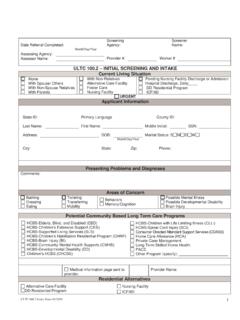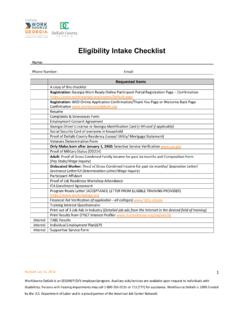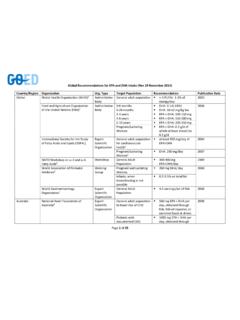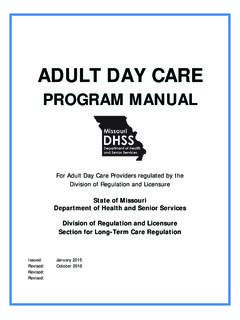Transcription of Dietary Reference Intakes Definitions - Canada
1 Dietary Reference Intakes Definitions Estimated Average Requirement (EAR) The EAR is the median daily intake value that is estimated to meet the requirement of half the healthy individuals in a life-stage and gender group. At this level of intake , the other half of the individuals in the specified group would not have their needs met. The EAR is based on a specific criterion of adequacy, derived from a careful review of the literature. Reduction of disease risk is considered along with many other health parameters in the selection of that criterion. The EAR is used to calculate the RDA. It is also used to assess the adequacy of nutrient Intakes , and can be used to plan the intake of groups. Recommended Dietary Allowance (RDA) The RDA is the average daily Dietary intake level that is sufficient to meet the nutrient requirement of nearly all (97 to 98 percent) healthy individuals in a particular life-stage and gender group.
2 The RDA is the goal for usual intake by an individual. Adequate intake (AI) If sufficient scientific evidence is not available to establish an EAR on which to base an RDA, an AI is derived instead. The AI is the recommended average daily nutrient intake level based on observed or experimentally determined approximations or estimates of nutrient intake by a group (or groups) of apparently healthy people who are assumed to be maintaining an adequate nutritional state. The AI is expected to meet or exceed the needs of most individuals in a specific life-stage and gender group. When an RDA is not available for a nutrient, the AI can be used as the goal for usual intake by an individual. The AI is not equivalent to an RDA. Tolerable Upper intake Level (UL) The UL is the highest average daily nutrient intake level likely to pose no risk of adverse health effects to almost all individuals in a given life-stage and gender group.
3 The UL is not a recommended level of intake As intake increases above the UL, the potential risk of adverse effects increases. Estimated Energy Requirement (EER) An EER is defined as the average Dietary energy intake that is predicted to maintain energy balance in healthy, normal weight individuals of a defined age, gender, weight, height, and level of physical activity consistent with good health. In children and pregnant and lactating women, the EER includes the needs associated with growth or secretion of milk at rates consistent with good health. Relative body weight ( loss, stable, gain) is the preferred indicator of energy adequacy. Acceptable Macronutrient Distribution Range (AMDR) The AMDR is a range of intake for a particular energy source (protein, fat, or carbohydrate), expressed as a percentage of total energy (kcal), that is associated with reduced risk of chronic disease while providing adequate Intakes of essential nutrients.
4 UPDATED NOVEMBER 2010 Dietary Reference Intakes Definitions Total Fibre The sum of Dietary Fibre and Functional Fibre. Dietary Fibre Non-digestible carbohydrates and lignin that are intrinsic and intact in plants. Dietary fibre includes plant non-starch polysaccharides ( cellulose, pectin, gums, hemicellulose, -glucans, and fibres contained in oat and wheat bran), plant carbohydrates that are not recovered by alcohol precipitation ( inulin, oligosaccharides, and fructans), lignin, and some resistant starch. Functional Fibre Isolated non-digestible carbohydrates that have been shown to have beneficial physiological effects in humans. Functional fibre includes isolated non-digestible plant ( resistant starch, pectin, and gums), animal ( chitin and chitosan), or commercially produced ( resistant starch, polydextrose, polyols, inulin, and indigestible dextrins) carbohydrate.
5 Physical Activity Level (PAL) The ratio of total energy expenditure to basal energy expenditure. The Physical Activity Level categories were defined as sedentary (PAL ), low active (PAL ), active (PAL ), and very active (PAL ). Physical Activity Level should not be confused with the physical activity coefficients (PA values) used in the equations to estimate energy requirement. Vitamin E The requirement for vitamin E is based on the 2R-stereoisomeric forms of alpha-tocopherol only. This includes RRR-alpha-tocopherol, which occurs naturally in foods, and the 2R-stereoisomeric forms (RRR- , RSR- , RRS- , and RSS- forms) that occur in supplements and fortified foods (all racemic alpha-tocopherol). Other forms of vitamin E do not contribute toward meeting the requirement. Previously, vitamin E activity was reported in alpha-tocopherol equivalents ( TE), which included all forms of vitamin E.
6 Alpha-tocopherol equivalents should be converted to milligrams of alpha-tocopherol. The UL for vitamin E applies to any isomeric form of supplemental alpha-tocopherol. REFERENCES: Dietary Reference Intakes for Calcium, Phosphorus, Magnesium, Vitamin D, and Fluoride (1997); Dietary Reference Intakes for Thiamin, Riboflavin, Niacin, Vitamin B6, Folate, Vitamin B12, Pantothenic Acid, Biotin, and Choline (1998); Dietary Reference Intakes for Vitamin C, Vitamin E, Selenium, and Carotenoids (2000); Dietary Reference Intakes for Vitamin A, Vitamin K, Arsenic, Boron, Chromium, Copper, Iodine, Iron, Manganese, Molybdenum, Nickel, Silicon, Vanadium, and Zinc (2001); Dietary Reference Intakes for Energy, Carbohydrate, Fiber, Fat, Fatty Acids, Cholesterol, Protein and Amino Acids (2002); Dietary Reference Intakes for Water, Potassium, Chloride, and Sulfate (2004).
7 Available at Dietary Reference Intakes Abbreviations and Reference Heights and Weights Abbreviations See Definitions and conversion factors for further details. AI Adequate intake AMDR Acceptable Macronutrient Distribution Range DFE Dietary Folate Equivalent EAR Estimated Average Requirement EER Estimated Energy Requirement g gram IU International Unit kcal kilocalorie kg kilogram m metre mg milligram N/A Not Applicable ND Not Determinable NE Niacin Equivalent PA Physical Activity Coefficient PAL Physical Activity Level RAE Retinol Activity Equivalent RDA Recommended Dietary Allowance RE Retinol Equivalent UL Tolerable Upper intake Level g microgram y year Reference Heights and Weights Reference Height (m) Reference Weight (kg) Reference Height (inches) Reference Weight (pounds)
8 Infants 2-6 mo 7-12 mo 6 9 24 28 13 20 Children 1-3 y 4-8 y 12 20 34 45 27 44 Males 9-13 y 14-18 y 19-30 y 36 61 70 57 68 70 79 134 154 Females 9-13 y 14-18 y 19-30 y 37 54 57 57 64 64 81 119 126 Calculated from median height and median body mass index for ages 4 through 19 years from CDC/NCHS growth charts ( ). Since there is no evidence that weight should change with ageing if activity is maintained, the Reference weights for adults 19-30 years of age apply to all adult age groups. Dietary Reference Intakes Unit Conversion Factors Vitamin A 1 RAE = 1 g retinol = IU retinol For preformed vitamin A, 1 RE = 1 RAE. Carotenoids 1 RAE = 12 g beta-carotene 1 RAE = 24 g alpha-carotene 1 RAE = 24 g beta-cryptoxanthin To calculate RAE from RE of provitamin A carotenoids in foods, divide RE by 2. Vitamin D 1 g = 40 IU Vitamin E 1 mg alpha-tocopherol = mg alpha-tocopherol equivalents ( TE) 1 mg alpha-tocopherol = IU d-alpha-tocopherol (natural, RRR form) 1 mg alpha-tocopherol = IU dl-alpha-tocopherol (synthetic, all racemic form)
9 Folate 1 DFE = 1 g food folate 1 DFE = g folic acid from fortified food or from a supplement consumed with food 1 DFE = g folic acid from a supplement taken on an empty stomach Niacin 1 NE = 1 mg niacin 1 NE = 60 mg tryptophan Sodium 1 g sodium = g salt Height 1 inch = m Weight 1 pound = kg Metric Units 1000 g = 1 mg 1000 mg = 1 g 1000 g = 1 kg Energy yield of macronutrients Carbohydrate = 4 kcal /g Protein = 4 kcal /g Fat = 9 kcal /g Alcohol = 7 kcal /g Dietary Reference Intakes Equations to estimate energy requirement Infants and young children Estimated Energy Requirement (kcal/day) = Total Energy Expenditure + Energy Deposition 0-3 months EER = (89 weight [kg] 100) + 175 4-6 months EER = (89 weight [kg] 100) + 56 7-12 months EER = (89 weight [kg] 100) + 22 13-35 months EER = (89 weight [kg] 100) + 20 Children and Adolescents 3-18 years Estimated Energy Requirement (kcal/day) = Total Energy Expenditure + Energy Deposition Boys 3-8 years EER = ( age [y]) + PA { ( weight [kg]) + (903 height [m]) } + 20 9-18 years EER = ( age [y]) + PA { ( weight [kg]) + (903 height [m]) } + 25 Girls 3-8 years EER = ( age [y]) + PA { ( weight [kg]) + (934 height [m]) } + 20 9-18 years EER = ( age [y]) + PA { ( weight [kg]) + (934 height [m]) } + 25 Adults 19 years and older Estimated Energy Requirement (kcal/day) = Total Energy Expenditure Men EER = 662 ( age [y]) + PA { ( weight [kg]) + ( height [m]) } Women EER = 354 ( age [y]) + PA { ( weight [kg]) + (726 height [m])}
10 } Pregnancy Estimated Energy Requirement (kcal/day) = Non-pregnant EER + Pregnancy Energy Deposition 1st trimester EER = Non-pregnant EER + 0 2nd trimester EER = Non-pregnant EER + 340 3rd trimester EER = Non-pregnant EER + 452 Lactation Estimated Energy Requirement (kcal/day) = Non-pregnant EER + Milk Energy Output Weight Loss 0-6 months postpartum EER = Non-pregnant EER + 500 170 7-12 months postpartum EER = Non-pregnant EER + 400 0 These equations provide an estimate of energy requirement. Relative body weight ( loss, stable, gain) is the preferred indicator of energy adequacy. Physical Activity Coefficients (PA values) for use in EER equations Sedentary (PAL ) Low Active (PAL ) Active (PAL ) Very Active (PAL ) Typical daily living activities ( , household tasks, walking to the bus) Typical daily living activities PLUS 30 - 60 minutes of daily moderate activity (ex.)

















